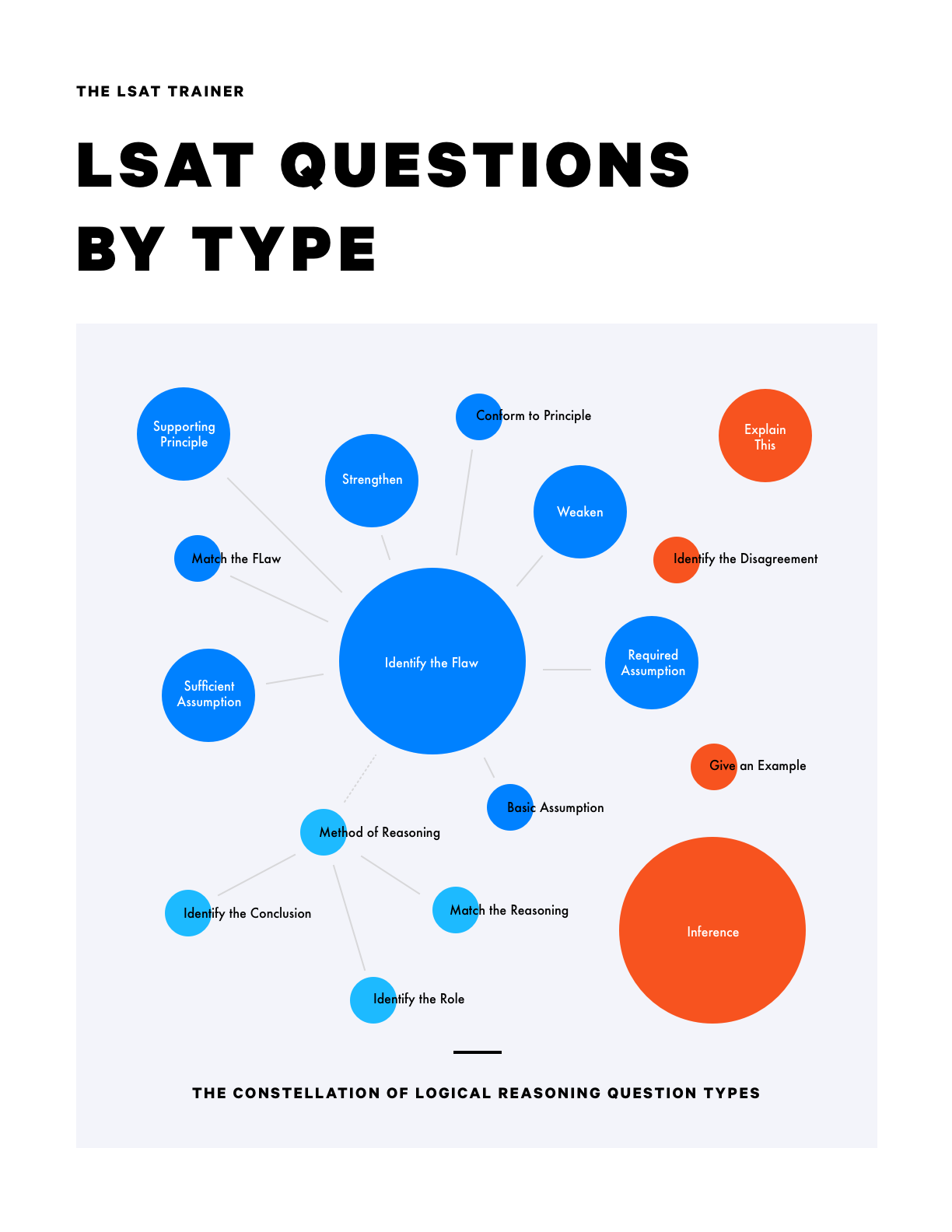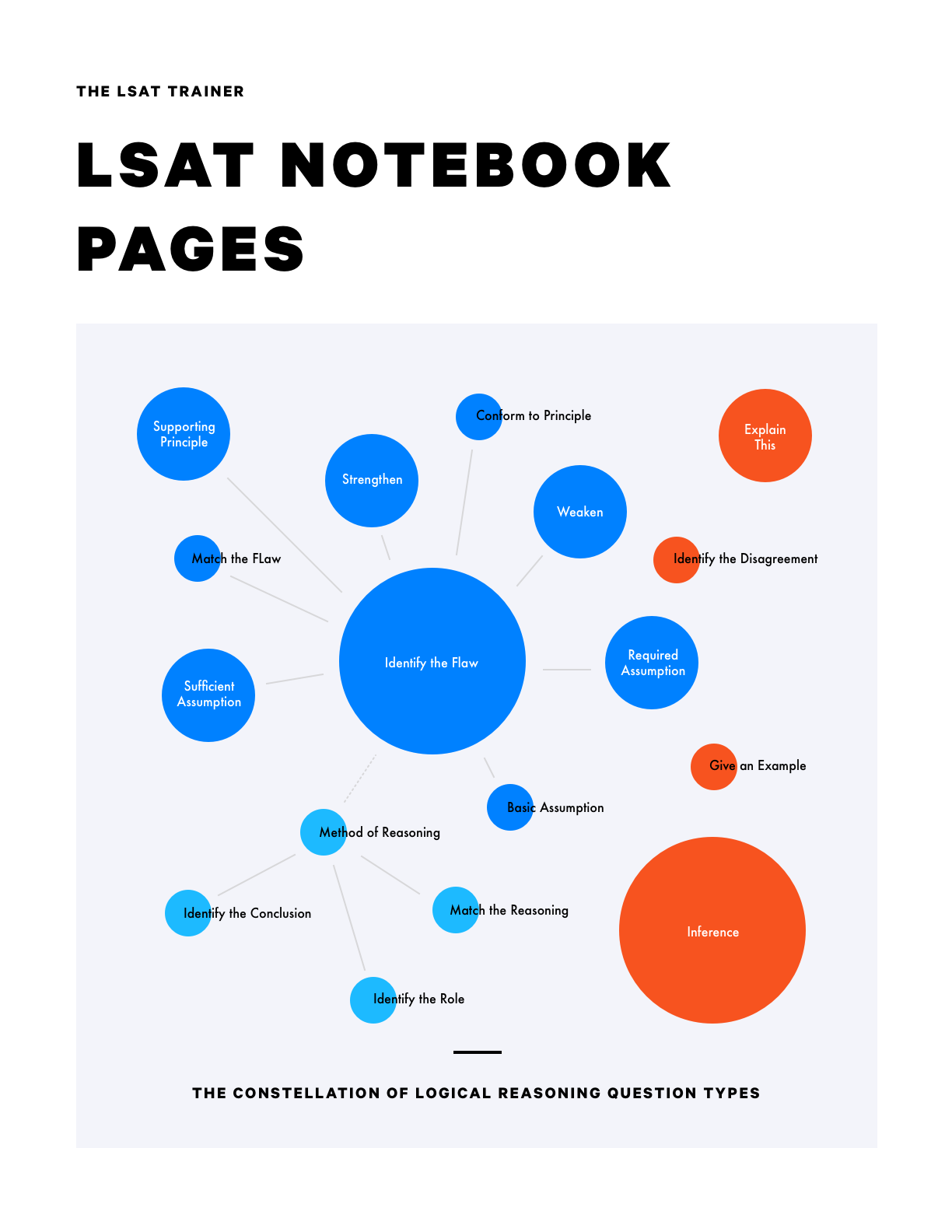Game 1
Step 1
Per the given scenario, we can write out the seven elements to be placed - Q, R, S, T, V, W, and X, and we can lay out the positions to be assigned in two groups - one group for the three that are selected, and one group for the four that are not. For the selected group, we can mark that one position is that of leader (L).
Step 2
Per the first rule, we can notate that if Q is in it must be the leader, and if R is in it must be the leader. We can also infer from this that both Q and R can’t be in together, and so one of those two must be out.
Step 3
Per the second rule, we can notate that if S is in, T must be in too, along with the contrapositive.
Step 4
Per the third rule, we can notate that if W is in, both R and V must be out, along with the contrapositives.
Step 5
We can notate that X is not restricted by any of the given rules.
Game 2
Step 1
Per the given scenario, we can write out the six elements to be placed - L, M, O, R, T, and Y - and we can lay out the six positions that need to be filled - four ordered for years 1921 - 1924, and two positions for those not assigned.
Step 2
Per the first rule, we can split our diagram into two frames, one in which L is assigned third, and one in which T is assigned third.
Step 3
Per the second rule, we can cross out M from underneath the fourth assignment in both frames.
Step 4
Per the third rule, we can split the first frame into two (which we will discuss as 1A and 1B), with T out in the first frame and T in in the second frame.
Step 5
For frame 1A, per the fourth rule, if R is in, O immediately precedes it.
Step 6
For frame 1B, per the third rule, since T is in, R must be in, and, per the fourth rule, if R is in, O must be placed right before it. The only way to satisfy these conditions in this frame is to place O in 1, R in 2, and T in 4. This puts M and Y into the out positions.
Step 7
For the second frame, per the third rule, since T is in, R must be in, and, per the fourth rule, that R must have an O right before it. In this frame, the O, R pairing can only go in 1 and 2. That leaves either L or Y to occupy the fourth position. This puts M and L or Y into the out positions.
Step 8
We can notate that Y is not directly restricted by any of the given rules.
Game 3
Step 1
Per the given scenario, we can write out the six elements to be placed - H, L, M, S, T, and V - and we can lay out the six assignments to be filled, in order.
Step 2
Per the first rule, we can notate that S cannot go in the first position.
Step 3
Per the fourth rule, we can create two different ordering frames - one in which T comes after V and before H, and another in which T comes after H and before V.
Step 4
Per the third rule, we can notate, in both ordering frames, that S comes before both V and M, and we can connect this to our notation for the fourth rule.
Step 5
In the first frame, we have the ordering of five elements, and, of the five, S must come earliest. However, we know, per the first rule, that S can’t be first. Thus, for the first ordering frame, we can infer that L must come before S.
Step 6
In the second frame, we don’t know where L goes in relation to the other elements, so we can notate that as well.
Step 7
Per the second rule, we can notate that if H is before L, M must be before L, as well as the contrapositive.
Game 4 (Option 1)
Step 1
Per the given scenario, we can write out the six elements - K, L, T, W, Y, and Z - and we can do so while also notating the subsets they fall into - recorded ( r ), or not recorded (n): Kr, Lr, Tn, Wn, Yn, and Zn. We can also lay out the six positions to be filled, in order.
Step 2
Per the first rule, we can notate that the fourth audition must be an n.
Step 3
Per the second rule, we can notate that the fifth audition must either be K or L (the two recorded sessions).
Step 4
Per the third rule, we can notate that W must come before both K and L (the two recorded sessions).
Step 5
Per the fourth rule, we can notate that T follows K, and we can connect this to our notation for the third rule.
Step 6
Per the fifth rule, we can notate that Z must come before Y.
Game 4 (Option 2)
Step 1
Per the given scenario, we can write out the six elements - K, L, T, W, Y, and Z - and we can do so while also notating the subsets they fall into - recorded ( r ), or not recorded (n): Kr, Lr, Tn, Wn, Yn, and Zn.
Step 2
Per the second rule, we can create two frames based off our options for the fifth position - Kr and Lr.
Step 3
In the first frame, we can infer, per the fourth rule, that T must go last.
Step 4
In the first frame, per the first rule, the fourth audition must be an n. Since, per the third rule, W can’t be in the fourth position, and, per the fifth rule, Z can’t be in the fourth position, we can infer that Y is the only n left that can fill the fourth position.
Step 5
That leaves us with Wn, Lr, and Zn to fill the first three positions, and, per the third rule, W must come before L.
Step 6
In the second frame, per the first rule, we can notate that the fourth recording is an n.
Step 7
In the second frame, per the third rule, we can notate that Wn is before Kr (there is no need to notate that Wn is before Lr because anything else is not possible in this frame).
Step 8
In the second frame, per the fourth rule, we can notate that T must follow K. We can connect this to our notation for the third rule.
Step 9
In the second frame, per the fifth rule, we can notate that Y must follow Z.



